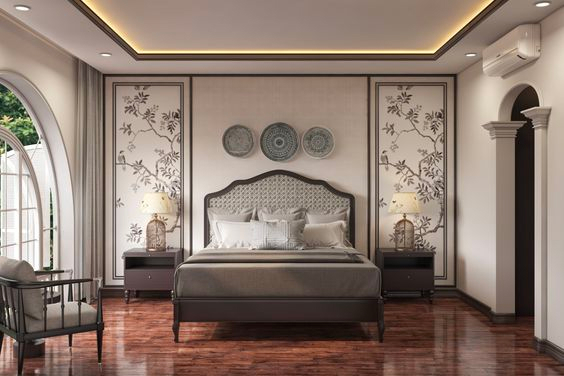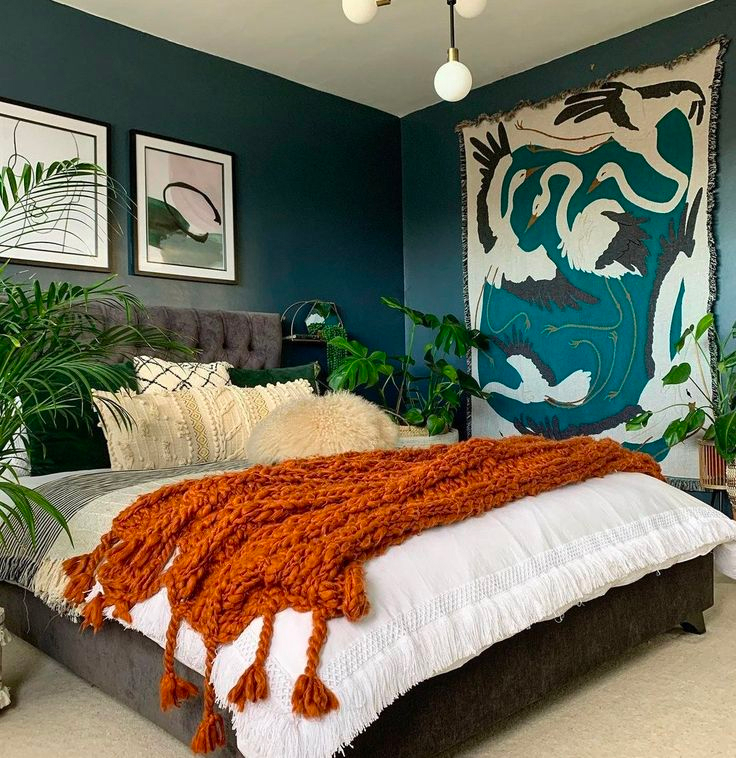Table of Contents
Create a rejuvenating haven in your bedroom, a space where you can recharge. If you find yourself having restless nights or feeling overstimulated before sleep, exploring Feng Shui adjustments could be beneficial. Drawing from this ancient Chinese practice, incorporating specific layout practices can foster harmony and energetic balance between you and your surroundings.
We explored to discover the most effective bedroom layout for Feng Shui, along with some inventive solutions.

1. The Ultimate Layout: Optimizing Your Space for Maximum Impact
To has a preferred, ideal layout that she frequently recommends to her clients:
The bed is positioned against a solid wall with a commanding view of the doorway, but the foot of the bed isn’t directly aligned with the door or any windows. The solid wall should not contain any plumbing or appliances on the other side to prevent overstimulation of energy. The bedside table is placed beside the bed but is not taller than the bed to avoid creating a sense of oppression. The layout is kept free of mirrors, plants, workspaces, or electronics, as these elements carry their own energetic charge according to Feng Shui.
We note that this ideal setup is not always possible or conducive to every lifestyle, but you can make small adjustments where needed. The following eight layouts we describe use this template as a guide, incorporating necessary adjustments depending on your situation.

2. Optimizing Attic Bedrooms: Effective Layout Adjustments
Arranging the ideal Feng Shui layout for a bedroom situated on the top floor with slanted ceilings can be challenging.
“If your bedroom has a noticeable slant that you might accidentally bump your head on, it’s advisable to avoid positioning your bed directly under the slant,” she advises. “In general, steer clear of anything that might create a sense of pressure on your crown chakra, located at the top of your head.”
If placing your bed under the slant is unavoidable, she recommends counteracting the downward energy by installing sconces on each side of the bed. These sconces should project uplifting energy towards the ceiling.
3. Optimizing Bedroom Greenery: Effective Layout Adjustments for Plants
Maybe your bedroom boasts the ideal natural light for plants, or perhaps every other space is already occupied. Regardless of your reasons for having a plant in your room, consider placing it on the opposite side of the room, away from your bed. We recommend selecting a plant with slow and downward growth, such as a trailing succulent.
To ensure the plants receive sufficient sunlight, you can position them in front of the window. Just make sure the foot of your bed is not directly aligned with the window.

4 .Optimizing Room Layouts: Strategic Adjustments for Multiple Doorways
Arranging the layout of a bedroom with multiple doors, including entrances to a bathroom, hallway, and closet, poses a challenge when trying to avoid aligning your bed directly with any of these doors.
While it may sound dramatic, positioning the foot of your bed facing a doorway is referred to as the “coffin position.” This term suggests that it can leave your energy feeling overly exposed, as if it’s being pulled out of the room where you sleep. Depending on what lies beyond that door, it could subject you to excessive activity or the energy present in the adjacent room.
In situations where aligning your bed with a door is unavoidable, we recommend choosing the closet door since it typically involves minimal activity.
5. Optimizing Spacious Bedrooms: Strategic Layout Adjustments
When your bedroom boasts ample square footage, the temptation to fill it with an abundance of furniture may arise. However, be cautious as excessive clutter can obstruct the flow of energy and disrupt Feng Shui principles. If you desire additional furniture, contemplate establishing a dedicated zone for sitting and relaxing. Anchor this space with a rug, positioning it on the opposite side from your bed.
6 .Optimizing Mirror Decor: Strategic Layout Adjustments
Mirrors are typically discouraged in bedrooms according to Feng Shui principles. However, if you choose to have one in your bedroom, ensure it is not directly facing your bed. Pay attention to what the mirror reflects; for instance, it’s preferable for a mirror to reflect calming artwork rather than a home office.
7 .Optimizing Room Layouts: Strategic Adjustments for Multiple Windows
When your bedroom is situated in a sunroom or a space with windows on three out of the four walls, finding a solid wall for your bed can be challenging. Make the most of the situation by positioning the bed where you can maintain visibility of the door, even if it means having your back against a window during sleep. Alternatively, consider opting for a canopy bed to instill a sense of safety and enclosure in the room.

8. Optimizing Bedroom-Workspace Layout: Strategic Adjustments
At times, the only available space for a work-from-home station is within your bedroom. While it’s not the most ideal setup in terms of work-life balance and Feng Shui, the placement of your desk can mitigate its negative impact. Steer clear of situating your desk directly next to your bed, as this arrangement can create a sense of restlessness when trying to sleep and vice versa.
9. Optimizing Layouts for Electronic Enthusiasts: Strategic Adjustments
Some individuals prefer to maintain a technology-free environment in their bedrooms. If you use your phone as an alarm clock, consider charging it just outside your bedroom door at night, ensuring you can still hear it. For those who enjoy watching TV in bed, explore the option of using a portable projector that can be stored in another room when not in use. Alternatively, if you have a TV, consider placing it in a media cabinet and closing the doors before bedtime. For an extra step, unplug it at night to further minimize electronic presence in the sleeping space.
Referenced from Pinterest.
Share this post:



